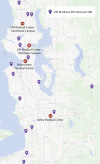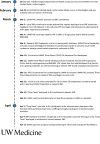A Health System Response to COVID-19 in Long-Term Care and Post-Acute Care: A Three-Phase Approach
- PMID: 32343363
- PMCID: PMC7267583
- DOI: 10.1111/jgs.16513
A Health System Response to COVID-19 in Long-Term Care and Post-Acute Care: A Three-Phase Approach
Abstract
Background: The Seattle, WA, area was ground zero for coronavirus disease 2019 (COVID-19). Its initial emergence in a skilled nursing facility (SNF) not only highlighted the vulnerability of its patients and residents, but also the limited clinical support that led to national headlines. Furthermore, the coronavirus pandemic heightened the need for improved collaboration among healthcare organizations and local and state public health.
Methods: The University of Washington Medicine's (UWM's) Post-Acute Care (PAC) Network developed and implemented a three-phase approach within its pre-existing network of SNFs to help slow the spread of the disease, support local area SNFs from becoming overwhelmed when inundated with COVID-19 cases or persons under investigation, and help decrease the burden on area hospitals, clinics, and emergency medical services.
Results: Support of local area SNFs consisted of the following phases that were implemented at various times as COVID-19 impacted each facility at different times. Initial Phase: This phase was designed to (1) optimize communication, (2) review infection control practices, and (3) create a centralized process to track and test the target population. Delayed Phase: The goals of the Delayed Phase were to slow the spread of the disease once it is present in the SNF by providing consistent education and reinforcing infection prevention and control practices to all staff. Surge Phase: This phase aimed to prepare facilities in response to an outbreak by deploying a "Drop Team" within 24 hours to the facility to expeditiously test patients and exposed employees, triage symptomatic patients, and coordinate care and supplies with local public health authorities.
Conclusions: The COVID-19 Three-Phase Response Plan provides a standardized model of care that may be implemented by other health systems and SNFs to help prepare and respond to COVID-19. J Am Geriatr Soc 68:1155-1161, 2020.
Keywords: COVID-19; coronavirus; long-term care; nursing home; post-acute care.
© 2020 The American Geriatrics Society.
Conflict of interest statement
This research received no specific funding/grant from any funding agency in the public, commercial, or not‐for‐profit sector. The authors declare no conflicts of interest.
Figures




Comment in
-
Time to Leverage Health System Collaborations: Supporting Nursing Facilities Through the COVID-19 Pandemic.J Am Geriatr Soc. 2020 Jun;68(6):1129-1130. doi: 10.1111/jgs.16540. Epub 2020 May 30. J Am Geriatr Soc. 2020. PMID: 32392623 No abstract available.
References
-
- Wu Z, McGoogan JM. Characteristics of and important lessons from the coronavirus disease 2019 (COVID‐19) outbreak in China: summary of a report of 72,314 cases from the Chinese Center for Disease Control and Prevention. JAMA. 2020;323(13):1239‐1242. - PubMed
-
- COVID‐19 Preparedness Checklist for Nursing Homes and Other Long‐Term Care Settings. Coronavirus Disease 2019 (COVID‐19). Centers for Disease Control and Prevention (online). https://www.cdc.gov/coronavirus/2019-ncov/downloads/novel-coronavirus-20.... Accessed April 4, 2020.
-
- Interim Additional Guidance for Infection Prevention and Control for Patients With Suspected or Confirmed COVID‐19 in Nursing Homes. Coronavirus Disease 2019 (COVID‐19). Centers for Disease Control and Prevention (online). https://www.cdc.gov/coronavirus/2019-ncov/hcp/long-term-care.html?CDC_AA.... Accessed April 4, 2020.
-
- Personal Protective Equipment (PPE) Burn Rate Calculator. Coronavirus Disease 2019 (COVID‐19). Centers for Disease Control and Prevention (online). https://www.cdc.gov/coronavirus/2019-ncov/hcp/ppe-strategy/burn-calculat.... Accessed April 9, 2020.
MeSH terms
LinkOut - more resources
Full Text Sources
Medical

